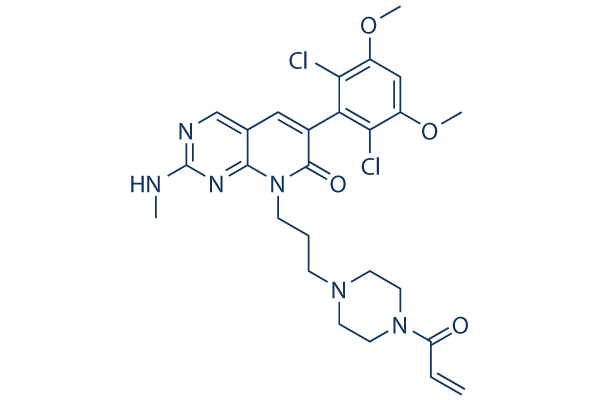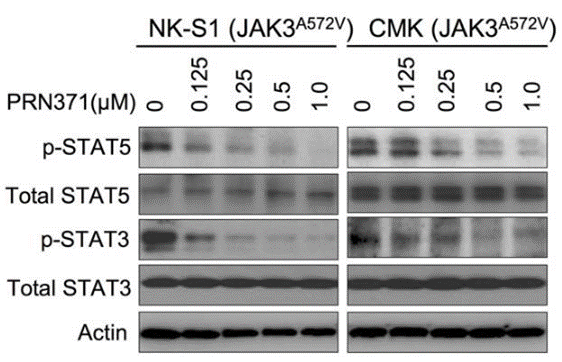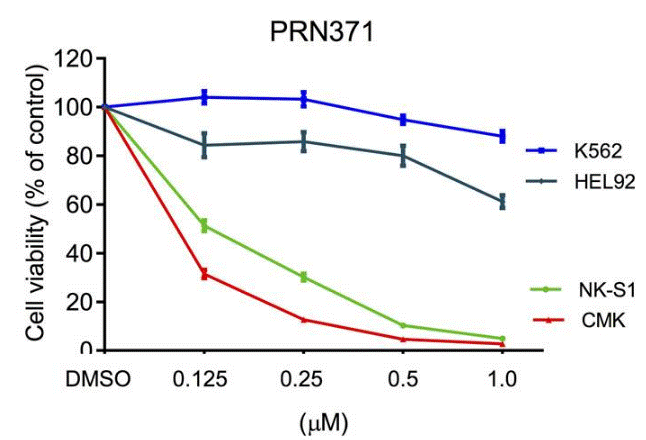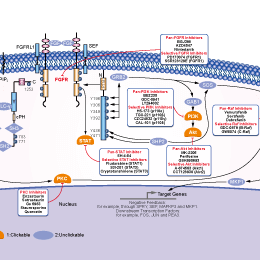
- Bioactive Compounds
- By Signaling Pathways
- PI3K/Akt/mTOR
- Epigenetics
- Methylation
- Immunology & Inflammation
- Protein Tyrosine Kinase
- Angiogenesis
- Apoptosis
- Autophagy
- ER stress & UPR
- JAK/STAT
- MAPK
- Cytoskeletal Signaling
- Cell Cycle
- TGF-beta/Smad
- DNA Damage/DNA Repair
- Compound Libraries
- Popular Compound Libraries
- Customize Library
- Clinical and FDA-approved Related
- Bioactive Compound Libraries
- Inhibitor Related
- Natural Product Related
- Metabolism Related
- Cell Death Related
- By Signaling Pathway
- By Disease
- Anti-infection and Antiviral Related
- Neuronal and Immunology Related
- Fragment and Covalent Related
- FDA-approved Drug Library
- FDA-approved & Passed Phase I Drug Library
- Preclinical/Clinical Compound Library
- Bioactive Compound Library-I
- Bioactive Compound Library-Ⅱ
- Kinase Inhibitor Library
- Express-Pick Library
- Natural Product Library
- Human Endogenous Metabolite Compound Library
- Alkaloid Compound LibraryNew
- Angiogenesis Related compound Library
- Anti-Aging Compound Library
- Anti-alzheimer Disease Compound Library
- Antibiotics compound Library
- Anti-cancer Compound Library
- Anti-cancer Compound Library-Ⅱ
- Anti-cancer Metabolism Compound Library
- Anti-Cardiovascular Disease Compound Library
- Anti-diabetic Compound Library
- Anti-infection Compound Library
- Antioxidant Compound Library
- Anti-parasitic Compound Library
- Antiviral Compound Library
- Apoptosis Compound Library
- Autophagy Compound Library
- Calcium Channel Blocker LibraryNew
- Cambridge Cancer Compound Library
- Carbohydrate Metabolism Compound LibraryNew
- Cell Cycle compound library
- CNS-Penetrant Compound Library
- Covalent Inhibitor Library
- Cytokine Inhibitor LibraryNew
- Cytoskeletal Signaling Pathway Compound Library
- DNA Damage/DNA Repair compound Library
- Drug-like Compound Library
- Endoplasmic Reticulum Stress Compound Library
- Epigenetics Compound Library
- Exosome Secretion Related Compound LibraryNew
- FDA-approved Anticancer Drug LibraryNew
- Ferroptosis Compound Library
- Flavonoid Compound Library
- Fragment Library
- Glutamine Metabolism Compound Library
- Glycolysis Compound Library
- GPCR Compound Library
- Gut Microbial Metabolite Library
- HIF-1 Signaling Pathway Compound Library
- Highly Selective Inhibitor Library
- Histone modification compound library
- HTS Library for Drug Discovery
- Human Hormone Related Compound LibraryNew
- Human Transcription Factor Compound LibraryNew
- Immunology/Inflammation Compound Library
- Inhibitor Library
- Ion Channel Ligand Library
- JAK/STAT compound library
- Lipid Metabolism Compound LibraryNew
- Macrocyclic Compound Library
- MAPK Inhibitor Library
- Medicine Food Homology Compound Library
- Metabolism Compound Library
- Methylation Compound Library
- Mouse Metabolite Compound LibraryNew
- Natural Organic Compound Library
- Neuronal Signaling Compound Library
- NF-κB Signaling Compound Library
- Nucleoside Analogue Library
- Obesity Compound Library
- Oxidative Stress Compound LibraryNew
- Plant Extract Library
- Phenotypic Screening Library
- PI3K/Akt Inhibitor Library
- Protease Inhibitor Library
- Protein-protein Interaction Inhibitor Library
- Pyroptosis Compound Library
- Small Molecule Immuno-Oncology Compound Library
- Mitochondria-Targeted Compound LibraryNew
- Stem Cell Differentiation Compound LibraryNew
- Stem Cell Signaling Compound Library
- Natural Phenol Compound LibraryNew
- Natural Terpenoid Compound LibraryNew
- TGF-beta/Smad compound library
- Traditional Chinese Medicine Library
- Tyrosine Kinase Inhibitor Library
- Ubiquitination Compound Library
-
Cherry Picking
You can personalize your library with chemicals from within Selleck's inventory. Build the right library for your research endeavors by choosing from compounds in all of our available libraries.
Please contact us at [email protected] to customize your library.
You could select:
- Antibodies
- Bioreagents
- qPCR
- 2x SYBR Green qPCR Master Mix
- 2x SYBR Green qPCR Master Mix(Low ROX)
- 2x SYBR Green qPCR Master Mix(High ROX)
- Protein Assay
- Protein A/G Magnetic Beads for IP
- Anti-Flag magnetic beads
- Anti-Flag Affinity Gel
- Anti-Myc magnetic beads
- Anti-HA magnetic beads
- Magnetic Separator
- Poly DYKDDDDK Tag Peptide lyophilized powder
- Protease Inhibitor Cocktail
- Protease Inhibitor Cocktail (EDTA-Free, 100X in DMSO)
- Phosphatase Inhibitor Cocktail (2 Tubes, 100X)
- Cell Biology
- Cell Counting Kit-8 (CCK-8)
- Animal Experiment
- Mouse Direct PCR Kit (For Genotyping)
- New Products
- Contact Us
PRN1371
PRN1371 is an irreversible covalent FGFR1-4 kinase inhibitor, with IC50s of 0.6, 1.3, 4.1, 19.3 and 8.1 nM for FGFR1, 2, 3, 4 and CSF1R, respectively.

PRN1371 Chemical Structure
CAS No. 1802929-43-6
Purity & Quality Control
Batch:
Purity:
99.87%
99.87
PRN1371 Related Products
| Related Targets | FGFR1 FGFR2 FGFR3 FGFR4 | Click to Expand |
|---|---|---|
| Related Products | Fexagratinib (AZD4547) PD173074 BLU9931 LY2874455 Zoligratinib (Debio-1347) Futibatinib (TAS-120) PD-166866 SSR128129E H3B-6527 Fisogatinib (BLU-554) Derazantinib FIIN-2 Ferulic Acid ASP5878 Roblitinib (FGF401) Alofanib (RPT835) NSC12 | Click to Expand |
| Related Compound Libraries | Tyrosine Kinase Inhibitor Library PI3K/Akt Inhibitor Library Angiogenesis Related compound Library HIF-1 Signaling Pathway Compound Library FDA-approved Anticancer Drug Library | Click to Expand |
Signaling Pathway
Biological Activity
| Description | PRN1371 is an irreversible covalent FGFR1-4 kinase inhibitor, with IC50s of 0.6, 1.3, 4.1, 19.3 and 8.1 nM for FGFR1, 2, 3, 4 and CSF1R, respectively. | ||||||||||
|---|---|---|---|---|---|---|---|---|---|---|---|
| Targets |
|
| In vitro | ||||
| In vitro | PRN1371 is an irreversible nanomolar inhibitor of FGFR1−4. PRN1371 presents a unique profile of high biochemical and cellular potency (FGFR1 IC50 = 0.6 nM, SNU16 IC50 = 2.6 nM), prolonged target engagement (FGFR1 occupancy 24 h = 96%), <30% hERG inhibition at 1 μM, and good predicted ADME stability with BME reactivity Kd>100 μM. PRN1371 which maintained high FGFR1 occupancy with improved solubility and exceptional oral bioavailability[1]. | |||
|---|---|---|---|---|
| Cell Research | Cell lines | HUVECs | ||
| Concentrations | -- | |||
| Incubation Time | 1 h | |||
| Method | Human umbilical vein endothelial cells (HUVECs) were incubated in media supplemented with 10% FBS and seeded at 30 000 cells per well in a 96-well plate overnight. HUVECs were then transferred into serum free media 1 h before compound treatment. A compound concentration series was added to cells and incubated for 1 h at 37 °C. Cells were then stimulated with either 50 ng/mL of FGF2 or 50 ng/mL of VEGF for 10 min. Ice cold PBS was added to stop the reaction, and cells were washed three times to remove media. ERK phosphorylation is determined. |
|||
| Experimental Result Images | Methods | Biomarkers | Images | PMID |
| Western blot | p-STAT5 / STAT5 / p-STAT3 / STAT3 |

|
29434279 | |
| Growth inhibition assay | Cell viability |

|
29434279 | |
| In Vivo | ||
| In vivo | A rat iv (2 mg/kg) PK study of compound 34 showed rapid clearance (Cl = 160 ml/min/kg), yet dosing po (20 mg/kg) demonstrated high oral exposure (AUC = 4348 h·ng/mL) and a reasonable half-life (t1/2 = 3.8 h). PK studies of compound 34 in rat, dog, and cynomolgus monkey showed rapid iv clearance in all species; however there were large species differences in oral exposure and bioavailability for monkey compared to rat and dog. In rat, high exposure upon oral dosing (e.g., Cmax = 1785 ng/mL, AUC = 4348 ng·h/mL) and >100% bioavailability (F) suggested good absorption and partial saturation of clearance mechanisms at the 20 mg/kg dose. Unique to the rat, there is a large difference in half-life between the iv (t1/2 = 0.8 h) and po (t1/2 = 3.8 h) routes of administration, also indicative of possible saturation of a clearance mechanism upon oral dosing. In the dogs, the same methylcellulose suspension formulation used for the rat gave low oral absorption and bioavailability (F < 15%). In SNU16 gastric cancer xenograft mouse model, Compound 34 induced a dose-dependent reduction in tumor volume and up to 68% tumor growth inhibition at the highest dose of 10 mg/kg b.i.d. following 27 days of treatment. All doses were well tolerated with no significant body weight loss[1]. | |
|---|---|---|
| Animal Research | Animal Models | SNU16 gastric cancer xenograft mouse model |
| Dosages | 10 mg/kg | |
| Administration | oral | |
| NCT Number | Recruitment | Conditions | Sponsor/Collaborators | Start Date | Phases |
|---|---|---|---|---|---|
| NCT02608125 | Terminated | Solid Tumors|Metastatic Urothelial Carcinoma & Renal Pelvis & Ureter |
Principia Biopharma a Sanofi Company |
October 28 2015 | Phase 1 |
Chemical Information & Solubility
| Molecular Weight | 561.46 | Formula | C26H30Cl2N6O4 |
| CAS No. | 1802929-43-6 | SDF | Download PRN1371 SDF |
| Smiles | CNC1=NC=C2C=C(C(=O)N(C2=N1)CCCN3CCN(CC3)C(=O)C=C)C4=C(C(=CC(=C4Cl)OC)OC)Cl | ||
| Storage (From the date of receipt) | |||
|
In vitro |
DMSO : 56 mg/mL ( (99.73 mM) Moisture-absorbing DMSO reduces solubility. Please use fresh DMSO.) Water : Insoluble Ethanol : Insoluble |
Molecular Weight Calculator |
|
In vivo Add solvents to the product individually and in order. |
In vivo Formulation Calculator |
||||
Preparing Stock Solutions
Molarity Calculator
In vivo Formulation Calculator (Clear solution)
Step 1: Enter information below (Recommended: An additional animal making an allowance for loss during the experiment)
mg/kg
g
μL
Step 2: Enter the in vivo formulation (This is only the calculator, not formulation. Please contact us first if there is no in vivo formulation at the solubility Section.)
% DMSO
%
% Tween 80
% ddH2O
%DMSO
%
Calculation results:
Working concentration: mg/ml;
Method for preparing DMSO master liquid: mg drug pre-dissolved in μL DMSO ( Master liquid concentration mg/mL, Please contact us first if the concentration exceeds the DMSO solubility of the batch of drug. )
Method for preparing in vivo formulation: Take μL DMSO master liquid, next addμL PEG300, mix and clarify, next addμL Tween 80, mix and clarify, next add μL ddH2O, mix and clarify.
Method for preparing in vivo formulation: Take μL DMSO master liquid, next add μL Corn oil, mix and clarify.
Note: 1. Please make sure the liquid is clear before adding the next solvent.
2. Be sure to add the solvent(s) in order. You must ensure that the solution obtained, in the previous addition, is a clear solution before proceeding to add the next solvent. Physical methods such
as vortex, ultrasound or hot water bath can be used to aid dissolving.
Tech Support
Answers to questions you may have can be found in the inhibitor handling instructions. Topics include how to prepare stock solutions, how to store inhibitors, and issues that need special attention for cell-based assays and animal experiments.
Tel: +1-832-582-8158 Ext:3
If you have any other enquiries, please leave a message.
* Indicates a Required Field
Tags: buy PRN1371 | PRN1371 supplier | purchase PRN1371 | PRN1371 cost | PRN1371 manufacturer | order PRN1371 | PRN1371 distributor







































